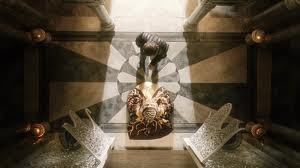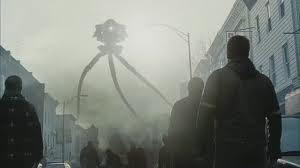 |
| lastsecondcomeback.blogspot.com |
Darren Aronofsky directed The Fountain (2006) after his plan of directing it the first time on a low budget failed. The film stars Hugh Jackman alongside Rachel Weisz, where they both play a couple who are opposite of each other; Jackman plays a neglectful, and busy Doctor, while Weisz plays an intellectual, and carefree writer. The story of the film is told in three ways; Jackman's character as a Doctor and his cancer-stricken wife, Jackman as a warrior and his wife as his queen, and Jackman as an insane, futuristic space traveler and the tree that he is so madly in love with..? (Jackman, Hugh) There is a difference between a story in a film and the plot. Corrigan & White explains the differences, but with the quote below, the course text emphasizes on the term “story”.
 |
| allmoviephoto.com |
“A story is the subject matter or raw material of a narrative, with the actions and events (usually perceived in terms of a beginning, a middle, and an end) ordered chronologically and focused on one or more characters, those who motivate the events and performs the action of the story,” (234). The moral of the story is to accept death once it has approached; you must take the time you have and spend it with them before they pass away. The story is about accepting death as it comes, but seeing the upside to it, the beauty of it, the precious time that is spent between one another in the midst of the difficult times (Jackman, Hugh).
 |
| slantmagazine.com |
Plot is different from story, and while many people may confuse the two, Corrigan & White (2009) helps us understand the contrasts in the quote: “The plot orders the events and actions of the story according to particular temporal and spatial patterns, selecting actions, individuals, and events and omitting others,” (234). The plot in The Fountain (2006) I'm not entirely too sure of, as the whole movie confused me (which is not a good thing), but I will try my best to explain it anyway (Jackman, Hugh).
 |
| moviesonline.ca |
So, it has already been established that the film focuses on two people: Jackman and Weisz's characters. The story centers on Jackman's dying wife, and he must learn to accept the fact that she is dying, and that he should have spent more time with her while she was alive. He learns that time is precious, and that life is something you cannot take for granted. So, yes, we know this, but it is how the story is told that defines the plot in the film, which, tells this story in three separate, confusing and slightly uninteresting scenes (Jackman, Hugh).
 |
| warezforum.info |
The movie opens with Jackman's character as the warrior who must save Spain and go back to his Queen. After the action in that story subsides, a new story has formed, with the space traveler guy sitting in mid air with his legs crossed, and at another scene, making love to a hairy tree, which most likely is a symbol of his wife. Thankfully, this second story also subsides and goes into a less confusing, and actually tolerable one, with Jackman's character sitting in his office, with that usually irritable look on his face; yelling at his sick, dying wife (Jackman, Hugh).
 |
| dvdbeaver.com |
These scenes can account for third-person narration because they are not seen in first-person perspective, but from how the audience sees the events in the film. The course text explains this concept further in the quote as follows: “[...] narration may assume a more objective and detached stance vis-a-vis the plot and characters, seeing events from outside the story […],” (236). Since the film mainly centers on Izzie and her sickness, I will use examples of the third-person narration in the movie relating to that. When Izzie is standing in the museum and suddenly collapses onto the floor, the audience is left not knowing what is wrong with her, but it is clear that she is sick, and not in fact “okay” as her husband wanted to believe, who was in denial the entire time about her sickness and about her coming death (Jackman, Hugh).
 |
| blog.moviefone.com |
In relation to this, when Izzie is laying in the bath tub, she tells her husband that she cannot feel hot or cold sensations, alluding to the fact that something is fatally wrong with her. It might just be me, but I as a viewer during both of these occasions had no idea what was wrong with her, or what her sickness was until late in the film (like everything else that occurred in the film). Then, it was revealed she had cancer, and these are the facts of the film. These facts that are presented to us viewers accounts as the third person- narrative. Her husband wanted to believe a lie that she was not sick and that she was going to make it, but the fact of the matter was this: the girl was a long goner (Jackman, Hugh).
Works Cited:
Corrigan, Timothy, and Patricia White. Film Experience: an Introduction. 2nd ed. New York, NY: Bedford/St. Martins, 2009. Print.
Jackman, Hugh, and Rachel Weisz, perf. The Fountain. Dir. Darren Aronofsky. 2006. Warner Bros. DVD.
































